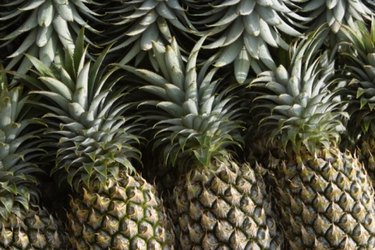
Bromeliads are neo-tropical to tropical plants. With more than 30 species and varieties, bromeliads range in shape, color and growth habit from the epyphetic Spanish moss to the upright, flowering urn plant to the high-colored foliage found in the Neoregelia species. Some bromeliads can live for decades while others only a few years. Many bromeliad species die after they flower. The timing of this event is dependent upon the bromeliad species and its growing conditions.
Life Cycle
Video of the Day
Bromeliads are either epiphytic of terrestrial. Epiphytic plants attach to a surface, such as another plant, a rock or a shell. They derive all of their needed nutrients and sustenance, including water, from the air around them. When these bromeliads reproduce, they do so via vegetative growth. Instead of seeds, they send out shoots that will then mature and detach from the mother plant to continue independent growth and maturation. The mother plant usually dies once the offspring have detached. Terrestrial bromeliads also follow this growth pattern but also propagate via seed. Instead of growing on an available surface they grow in light soil and send their shoots, or pups, into the growing medium. These pups detach and mature, leaving the central plant to die. Seeds will take root and develop into a new plant.
Video of the Day
Flowering Time
Bromeliads are slow-growing and long-lived. Pineapple, perhaps the most well known bromeliad, takes 18 to 36 months to flower and produce fruit. Some bromeliads take up to five years before producing a flower. The giant airplant is extremely long lived. This bromeliad lives for up to 20 years and produces flowers and seed. If you plan on encouraging flowering, vegetative growth and propagation, then place your bromeliad and an apple in a transparent, airtight plastic bag for 48 to 72 hours. Flowers will emerge in six weeks to two months.
Care and Maintenance
To encourage healthy growth, ensure that your growing conditions, whether indoors or out, are highly humid. Bromeliads, especially those of the epiphytic variety, take in moisture through the air. Some bromeliads are called tank bromeliads because they contain a cup, or tank, that holds water. Keep the bromeliads' cup filled with water. Periodically flush out the old water and replace with fresh water; this prevents bacterial and fungal growth. Terrestrial bromeliads grow best in light soil. Porous soils allow deep watering without saturation. Allow plants to dry out between waterings and never let them sit in soggy soils. A healthy central plant will flower and produce healthy pups. Under good conditions, this life cycle can continue for years.
Considerations
Bromeliads do not grow outdoors in cool climates. In the United States, bromeliads can be found in Florida and portions of Texas and other states bordering Mexico. If you live in these regions, purchase bromeliad varieties native to your region. Some bromeliads are considered invasive when they escape cultivation and effectively choke out native plants.